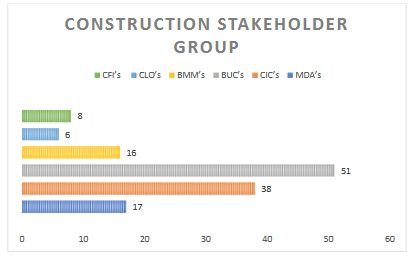Knowledge, Adoption, Prospects and Challenges of Prefabricated Construction Method in Nigeria
An Empirical Study of North Central Geo-Political Zone
Abstract
 Abstract Views: 297
Abstract Views: 297
Despite the numerous benefits of prefabricated construction method, there is unfortunately limited knowledge and adoption of this method in Nigeria’s construction industry. This study, therefore, seeks to assess the construction industry’s stakeholders’ level of knowledge and extent of adoption of prefabricated construction method in project delivery. It also evaluates the prospects and challenges of prefabricated construction considering the government’s huge annual investment in the nation’s construction industry sector. The methodology used in this study was descriptive survey involving a structured questionnaire administered to major construction industry stakeholders including the government, consultants, contractors, building material merchants, and construction financiers with practices in Nigeria’s north central geo-political zone. The study showed a low level of knowledge (MMS: 2.32) and low level of adoption (MMS: 2.13) of prefabricated construction method in Nigeria in general. It also revealed ‘Better Supervision’ (MS: 4.02) and ‘High Initial Costs’ (MS:3.62) as the highest prospects and challenges of prefabricated construction method among other identified factors. The study concluded that the low level of adoption arising from the low level of knowledge of prefab system in the nation’s construction industry was responsible for the myriad of delays in meeting project timelines, hence the prevalence of construction time–cost overruns. The current study recommends a review of the academic curriculum of built environment and professional development programmes to expand and deepen the prefab system training content. It also recommends wide adoption of prefab system considering their prospects of ensuring quality as a result of better supervision and suggests outsourcing on critical areas of organisations’ logistic weaknesses to minimize the problem of higher initial costs.
Downloads
References
Aibinu, A., & Jagboro, G. (2002). The effects of construction delays on project delivery in Nigerian Construction industry. International Journal of Project Management, 20, 593-599.
Ajanlekoko, J. (1990). The rise in costs of building materials and the structural adjustment progremme-how Proportionnate? The Nigeria Quantity Surveyor, 9, 44-55.
Aje, O., Odusami, K., & Ogunsemi, D. (2009). The impact of contractors' management capability on cost and time performance of construction projects in Nigeria. Journal of Financial Management of Property and Construction, 14(2), 171-187.
Arif, M., & Egbu, C. (2010). Making a case for offsite construction in China. Engineering Construction and Architectural Management, 17(6), 536-548.
Babic, N. C., Peter, P., & Danijel, R. (2010). Integrating resource production and construction using BIM. Automation in Construction, 19, 539-543.
Blismas, N., Pendlebury, M., Gibb, A., & Pasquire, C. (2005). Constraints to the use of offsite production on construction projects. Journal of Architecture, Engineering and Design Management, 1(3), 153-62.
Chen, Y., Okodan, G. E., & Riley, D. R. (2010). Decision support for construction model selection in concrete buildings: Prefabrication adoption & optimization. Automation in Construction, 19, 665-675.
Federal Office of Statistics. (1997). National Accounts of Nigeria 1991-1997. Author.
Isa, R. B., Jimoh, R. A., Achuenu, E. (2013). An overview of the contribution of the construction sector to sustainable development in Nigeria. Net Journal of Business Management, 1(1), 1-6.
Ismaila, O. M., Adegbenga, R. A. (2018). The sustainability of health and safety on construction sites in Zamfara state. Retrieved from https://www.workzonesafety.org/publication/the-sustainability-of-health-and-safety-on-construction-sites-in-zamfara-state/
Jaillon, L., & Poon, C.-S. (2010). Design issues of using prefabrication in Hong Kong building construction. Construction Management and Economics, 28, 1025-1042.
Kolo, B. A., Ibrahim, A. D. (2010). Value management: How adoptable is it in the Nigeria construction industry? Retrieved from https://catalog.ihsn.org/index.php/citations/61420
Lei, J., Zhongfu, L., Long, L., Yunli G. (2018). Constraints on the promotion of prefabricated construction in China. Sustainability, 10(7), 1-17. doi:10.3390/su10072516
Lessing, J. (2015). Industrialized house-building, conceptual orientation and strategic perspective. Faculty of Engineering, Lund University.
Li, H., Guo, H., Skitmore, M., Huang, T., Chan, K., & Chan, G. (2011). Rethinking prefabrication construction management using the VP-based. Construction Management and Economics, 29, 233-245.
Loosemore, M., Andrew, D., & Lingard, H. (2003). Human resourse management in construction projects; strategic and operational approaches. Taylor and Francis.
Mbamali, I., Aiyetan, O., & Kehinde, J. (2005). Building design for buildability: An investigation of the current practice in Nigeria. Building and Environment, 40(9), 1267-1274.
Niclas, A., Jerker, L. (2017). The interface between industrialization and project base construction. Paper presented at Creative Construction Conference, Primosten, Croatia.
National Bureau of Statistics. (2015). Nigerian Gross Domestic Product Report. Author.
Ogunsemi, D. R., & Jagboro, G. O. (2006). Time-cost model for building Projects in Nigeria. Construction Management and Economics, 24, 258-353.
Okuwoga, A. (1998). Cost-time performance of public sector housing projects in Nigeria. Habitat International, 22, 389-9.
Oladapo, A. (2007). A quantitative assessment of the cost and time impact of variation orders on construction projects. Journal of Engineering Design and Tecnology, 5, 35-48.
Osaba, E. (1993). Construction site management training. Construction in Nigeria, 10, 9-15.
Proverbs, D. C., Holt, G. D., & Olomolaiye, P. O. (1999). The management of labour on high rise construction projects; An international investigation. International Journal of Project Management (IJPM), 7(3), 195-204.
Sanusi, A. D. (2009). General overview of the Nigerian construction industry (Thesis M. Engineering). Department of Civil and Environmental Engineering, Massachusetts Institute of Technolgy.
Stallen, M., Chabannes, Y., & Steinberg, F. (1994). Potential of prefabrication for self-help and mutual-aid housing in developing countries. Habitat International, 18(2), 13-39.
Tam, V. W., Tam, C. W., Zeng, S. X., & William, C. (2007). Towards adoption of prefabrication in construction. Building and Environment, 42, 3642-3654.
Taylor, M. D. (2010). A definition and evaluation of the UK offsite construction sector. Construction Management and Economics. 28(8), 885-896.
Umar, A. H. (2015). An assessment of the Nigerian construction industry’s readiness to adopt value management process in effective project delivery (Master thesis). Department of Project Management, Ahmadu Bello University, Zaria.

Copyright (c) 2020 Chinedu Chimdi Adindu, Susan Nnadzwa Yisa, Saheed Olanrewaju Yusuf, Joseph Kolawole Makinde, Aliyu Muhammed Kamilu

This work is licensed under a Creative Commons Attribution 4.0 International License.
JAABE follows an open-access publishing policy and full text of all published articles is available free, immediately upon publication of an issue. The journal’s contents are published and distributed under the terms of the Creative Commons Attribution 4.0 International (CC-BY 4.0) license. Thus, the work submitted to the journal implies that it is original, unpublished work of the authors (neither published previously nor accepted/under consideration for publication elsewhere). On acceptance of a manuscript for publication, a corresponding author on the behalf of all co-authors of the manuscript will sign and submit a completed Copyright and Author Consent Form.
Copyright (c) The Authors





